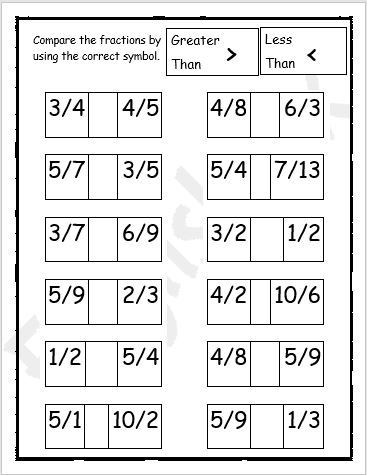


Since any number times 1 is equal to itself.we can say that 5/8 is equal to 15/24. Since any number times 1 is equal to itself. So when we multiply 5/8 by 3/3.we're really multiplying 5/8 by 1. We can do that because any number over itself is equal to 1. Since we multiplied the denominator by 3, we'll also multiply the numerator, or top number, by 3.ĥ times 3 equals 15. In order to change the denominator to 24.we had to multiply 8 by 3. In order to change the denominator to 24. To do that, we'll have to change the numerators the same way we changed the denominators. Now we're going to change our fractions so they both have the same denominator: 24. It looks like there are a few numbers that can be divided evenly by both 6 and 8.Ģ4 is the smallest number that appears on both rows, so it's the lowest common denominator. All of the numbers in the 6 row can be divided evenly by 6. We can use the multiplication table again. Now let's look at our second denominator: 6. All of the numbers on the 8 row can be divided evenly by 8. Using a multiplication table makes this easy. Our first step is to find numbers that can be divided evenly by 8. We call that the lowest common denominator. Let's compare these fractions: 5/8 and 4/6.īefore we compare them, we need to change both fractions so they have the same denominator, or bottom number.įirst, we'll find the smallest number that can be divided by both denominators.
#Fractions greater than less than equal to how to#
With an illustration, it was easy to compare these fractions, but how could we have done it without the picture?Ĭlick through the slideshow to learn how to compare fractions with different denominators. If you look at the picture, though, the difference is clear: 2/3 is larger than 1/5. The larger the numerator, the larger the fraction. As you can see below, 3/4 is larger than 1/4. 6 is larger than 2, so 6/8 is more than 2/8.Īs you saw, if two or more fractions have the same denominator, you can compare them by looking at their numerators. If you thought 6/8 was larger, you were right!īoth fractions have the same denominator. Here, 5 is more than 4.so we can tell that 5/6 is more than 4/6. This means we can compare these fractions just by looking at the numerator. When fractions have the same denominator, it means they're split into the same number of parts. The numerator tells us how many of those parts we have. The denominator tells us how many parts are in a whole. The other is the bottom number, or denominator. One part is the top number, or numerator. But how could we have done it without the pictures?Ĭlick through the slideshow to learn how to compare fractions.Įarlier, we saw that fractions have two parts. The illustration makes it easy to compare these fractions. In this image, we can see that 7/8 is larger.


 0 kommentar(er)
0 kommentar(er)
